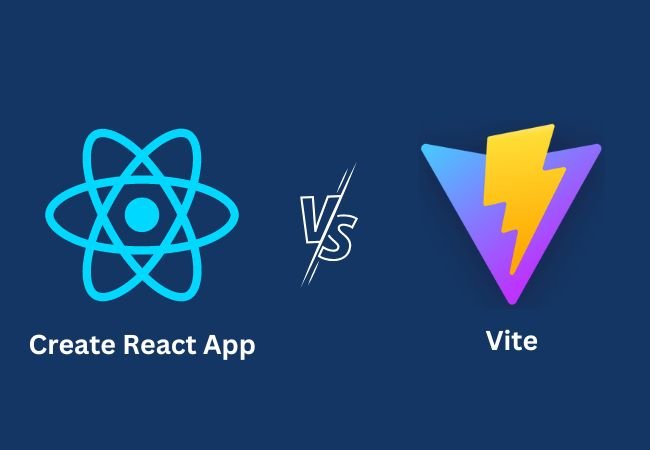Vite and Create React App are two popular tools used in the development of React applications. While both serve the purpose of simplifying the development process, they have fundamental differences in terms of configuration, performance optimizations, and development experience.
Contents
Create React App vs Vite: What is the difference?
Vite and Create React App are both popular tools used in the development of React applications, but they have some fundamental differences in terms of their purpose, configuration, and performance optimizations. Let’s explore these differences in detail:
Purpose:
Create React App (CRA): Create React App is a development toolchain provided by Facebook that offers a pre-configured setup for building React applications. It aims to provide a seamless and hassle-free experience for developers by abstracting away most of the configuration decisions.
Vite React: Vite is a build tool specifically designed for modern web development. Vite React is a template or starter project that combines Vite with React, providing an optimized development environment for React applications.
Configuration:
CRA: Create React App comes with a pre-configured setup, which includes tools like Webpack, Babel, and Jest. The configuration is hidden from the developers by default, providing a “zero-configuration” experience. However, CRA does provide an “eject” command to expose and customize the underlying configuration if needed.
Vite React: Vite uses a different approach to configuration. It leverages ES modules, native browser features, and on-demand compilation to eliminate the need for complex bundling during development. This makes the configuration simpler and faster compared to traditional bundlers like Webpack.
Development Experience:
CRA: Create React App focuses on providing a smooth development experience by abstracting away the build setup. It offers features like hot module replacement (HMR), live reloading, and a pre-configured development server. It also provides a set of predefined scripts for common tasks like running the development server, building the project for production, and running tests.
Vite React: Vite takes advantage of ES modules and modern browser capabilities to provide an even faster development experience. It leverages native browser imports, which eliminates the need for bundling during development. This results in instant startup times and faster HMR. Vite also supports React Fast Refresh, which allows for faster reloading of components during development.
Performance:
CRA: Create React App uses a traditional bundling approach with tools like Webpack, which generates a bundled JavaScript file that includes all the project’s dependencies. This bundling process can take some time, especially for larger projects. However, the bundled output is optimized for production, resulting in smaller file sizes and better performance in the browser.
Vite React: Vite focuses on leveraging native ES module imports and on-demand compilation during development, which eliminates the need for upfront bundling. This leads to faster development server startup times and quicker HMR. In production, Vite generates highly optimized, pre-bundled static assets for better performance.
Extensibility:
CRA: Create React App provides a curated and locked-down configuration by default, which means that some customization options may be limited. However, if more advanced configurations are required, the “eject” command can be used to expose the underlying configuration files and dependencies for manual customization.
Vite React: Vite’s configuration is more flexible and can be extended easily. It supports plugins and allows developers to customize the build process by modifying the configuration file. This provides more control over the project’s setup and allows for integrating additional tools and features.
In summary, Create React App is a popular choice for developers who prefer a zero-configuration approach, simplicity, and a smooth development experience. On the other hand, Vite React is geared towards providing a faster development experience, leveraging native browser capabilities, and offering more flexibility for customization.
The choice between the two depends on the specific requirements and preferences of the project and the development team.
To create a React app using Vite, follow these steps:
- Ensure that you have Node.js installed on your machine. You can check this by running the command
node -vin your terminal. If Node.js is not installed, you can download and install it from the official Node.js website. - Open your terminal and navigate to the directory where you want to create your React app.
- Run the following command to initialize a new Vite project:
npx create-vite@latest my-react-app --template react
This command uses the create-vite package to scaffold a new Vite project. The my-react-app argument specifies the name of your project, and the --template react flag selects the React template.
- Once the command completes, navigate into the project directory:
cd my-react-app
- Finally, start the development server by running:
npm run dev
This will compile your React app and launch a development server. You can now start building your app using Vite.
To create a React app using Create React App (CRA), follow these steps:
- Ensure that you have Node.js installed on your machine. You can check this by running the command
node -vin your terminal. If Node.js is not installed, you can download and install it from the official Node.js website. - Open your terminal and navigate to the directory where you want to create your React app.
- Run the following command to create a new React app with CRA:
npx create-react-app my-react-app
This command uses the create-react-app package to scaffold a new React project. The my-react-app argument specifies the name of your project.
- Once the command completes, navigate into the project directory:
cd my-react-app
- Finally, start the development server by running:
npm start
This will compile your React app and launch a development server. You can now start building your app using Create React App.
In both cases, once the development server is running, you can open your browser and access your React app at http://localhost:3000 by default. From there, you can start editing the source files and see the changes reflected in the browser as you develop your React application.
Why use Vite instead of React?
When it comes to choosing a technology stack for building web applications, the decision often revolves around the trade-offs and specific requirements of the project. While React has gained immense popularity as a powerful JavaScript library for building user interfaces, Vite emerges as a compelling alternative, particularly when considering search engine optimization (SEO) friendliness.
Vite, a build tool developed by the Vue.js team, offers several advantages that make it an attractive choice for SEO-friendly web development. One notable feature is its lightning-fast development server, which leverages native ES modules to achieve near-instantaneous hot module replacement.
This results in a highly efficient development experience, allowing developers to rapidly iterate and test changes.
Additionally, Vite embraces a server-side rendering (SSR) approach by default, which can significantly enhance a website’s SEO capabilities. Server-side rendering allows search engine crawlers to easily access and interpret the content of web pages, ultimately improving their visibility in search engine rankings.
React, on the other hand, primarily focuses on client-side rendering (CSR), which can limit SEO potential unless additional tools or frameworks are employed.
Furthermore, Vite’s dependency on ES modules provides built-in tree-shaking capabilities. Tree shaking is an optimization technique that eliminates unused code during the build process, resulting in smaller and faster-loading JavaScript bundles. This efficient bundling can positively impact a website’s performance, user experience, and even SEO ranking, as search engines tend to favor fast-loading websites.
It’s important to note that React can also be used with Vite. In fact, Vite offers a React-specific plugin, allowing developers to leverage the benefits of both React and Vite in their projects. This combination can provide the best of both worlds—React’s robust component model and Vite’s fast development server and SEO-friendly features.
Ultimately, the decision to use Vite instead of React or vice versa depends on the specific requirements and priorities of the project. If SEO friendliness is a paramount concern, Vite’s default server-side rendering and efficient bundling make it an excellent choice. However, if you’re already familiar with React or have specific needs that React addresses better, combining React with Vite can be a compelling option to consider.
Should you still use create React app?
Create React App has been a go-to tool for bootstrapping React applications for several years. It offers a battle-tested configuration out of the box, making it easy to start a new project without worrying about complex setup tasks. CRA provides a preconfigured webpack setup, Babel for transpiling code, and a sensible folder structure to organize your code. It also comes with features like hot module replacement and code splitting, which are essential for a smooth development experience. Create React App is well-documented, widely used, and has a large community, making it easier to find support and resources.
On the other hand, Vite is a relatively new build tool that has gained significant popularity in the React ecosystem. Vite takes a different approach by leveraging native ES modules to achieve blazing-fast development server startup times. Unlike CRA, Vite doesn’t require a time-consuming initial build process and instead uses on-demand compilation. This means that changes to your code are reflected almost instantly in the browser, making the development workflow incredibly snappy. Vite also offers built-in support for various front-end frameworks and libraries, including React, making it a versatile choice.
When deciding between Create React App and Vite, there are a few factors to consider. If you value simplicity and ease of setup, Create React App might be the better choice. It provides a more opinionated configuration, which can be beneficial if you don’t want to spend time tweaking build settings. Additionally, if you’re working on a large-scale project or need more advanced features like service workers or custom webpack configurations, Create React App offers a more comprehensive and battle-tested solution.
On the other hand, if development speed and instant feedback are a priority, Vite shines in this area. With its lightning-fast hot module replacement and on-demand compilation, you can see your changes reflected in the browser almost immediately, significantly reducing the development cycle. Vite’s flexibility and extensibility also make it a great choice if you prefer a more customized build setup or if you’re working on smaller projects or prototypes where simplicity and quick iteration are key.
Ultimately, the choice between Create React App and Vite depends on your specific project requirements and personal preferences. If you prioritize a robust and well-established setup with comprehensive features and a larger community support base, Create React App is still a reliable choice. However, if you’re looking for faster development feedback and a more flexible and extensible configuration, Vite might be the more suitable option. Regardless of your choice, both tools provide efficient ways to kickstart your React projects and contribute to an enjoyable development experience.






0 Comments